Peroxiredoxins Play an Important Role in the Regulation of Immunity and Aging in Drosophila
Abstract
1. Introduction
2. Materials and Methods
2.1. Fly Strains and Procedures
2.2. Intestinal Barrier Dysfunction
2.3. Bacterial Load Study
2.4. DNA Preparation
2.5. Quantitative RT-PCR and Immunoblot Analyses
2.6. Statistical Methods
3. Results
3.1. Life Span of Flies Under-Expressing Mitochondrial Peroxiredoxins in Intestinal Epithelium and Fat Bodies
3.2. Age-Dependent Changes in Intestinal Barrier Function in the Double and Single dPrx Mutants
3.3. The Overactivation of AMPs in the DM Was Not Due to Changes in Microbial Load
3.4. dPrx5 Suppresses Hyperactive Immunity in Old Flies Due to Its Peroxidase Activitye
3.5. Interactions between the ER and Mitochondrion-Mediated Signaling in Eliciting an Age-Related Chronic Inflammatory Response
4. Discussion
Supplementary Materials
Author Contributions
Funding
Institutional Review Board Statement
Informed Consent Statement
Data Availability Statement
Conflicts of Interest
References
- Hearps, A.C.; Martin, G.E.; Angelovich, T.A.; Cheng, W.J.; Maisa, A.; Landay, A.L.; Jaworowski, A.; Crowe, S.M. Aging is associated with chronic innate immune activation and dysregulation of monocyte phenotype and function. Aging Cell 2012, 11, 867–875. [Google Scholar] [CrossRef]
- Le Saux, S.; Weyand, C.M.; Goronzy, J.J. Mechanisms of immunosenescence: Lessons from models of accelerated immune aging. Ann. N. Y Acad. Sci. 2012, 1247, 69–82. [Google Scholar] [CrossRef] [PubMed]
- Zanini, G.; Selleri, V.; Lopez Domenech, S.; Malerba, M.; Nasi, M.; Mattioli, A.V.; Pinti, M. Mitochondrial DNA as inflammatory DAMP: A warning of an aging immune system? Biochem. Soc. Trans. 2023, 51, 735–745. [Google Scholar] [CrossRef] [PubMed]
- Asri, R.M.; Salim, E.; Nainu, F.; Hori, A.; Kuraishi, T. Sterile induction of innate immunity in Drosophila melanogaster. Front. Biosci. 2019, 24, 1390–1400. [Google Scholar] [CrossRef]
- Shaukat, Z.; Liu, D.W.; Gregory, S. Sterile Inflammation in Drosophila. Mediat. Inflamm. 2015, 2015, 369286. [Google Scholar] [CrossRef] [PubMed]
- Buchon, N.; Broderick, N.A.; Chakrabarti, S.; Lemaitre, B. Invasive and indigenous microbiota impact intestinal stem cell activity through multiple pathways in Drosophila. Genes Dev. 2009, 23, 2333–2344. [Google Scholar] [CrossRef] [PubMed]
- Kim, S.H.; Lee, W.J. Role of DUOX in gut inflammation: Lessons from Drosophila model of gut-microbiota interactions. Front. Cell Infect. Microbiol. 2014, 3, 116. [Google Scholar] [CrossRef] [PubMed]
- Odnokoz, O.; Nakatsuka, K.; Klichko, V.I.; Nguyen, J.; Solis, L.C.; Ostling, K.; Badinloo, M.; Orr, W.C.; Radyuk, S.N. Mitochondrial peroxiredoxins are essential in regulating the relationship between Drosophila immunity and aging. Biochim. Biophys. Acta 2017, 1863, 68–80. [Google Scholar] [CrossRef]
- Klichko, V.I.; Orr, W.C.; Radyuk, S.N. The role of peroxiredoxin 4 in inflammatory response and aging. Biochim. Biophys. Acta 2016, 1862, 265–273. [Google Scholar] [CrossRef]
- Radyuk, S.N.; Michalak, K.; Klichko, V.I.; Benes, J.; Orr, W.C. Peroxiredoxin 5 modulates immune response in Drosophila. Biochim. Biophys. Acta 2010, 1800, 1153–1163. [Google Scholar] [CrossRef]
- Hansen, J.M.; Moriarty-Craige, S.; Jones, D.P. Nuclear and cytoplasmic peroxiredoxin-1 differentially regulate NF-kappaB activities. Free Radic. Biol. Med. 2007, 43, 282–288. [Google Scholar] [CrossRef]
- Radyuk, S.N.; Klichko, V.I.; Michalak, K.; Orr, W.C. The effect of peroxiredoxin 4 on fly physiology is a complex interplay of antioxidant and signaling functions. FASEB J. Off. Publ. Fed. Am. Soc. Exp. Biol. 2013, 27, 1426–1438. [Google Scholar] [CrossRef] [PubMed]
- Rhee, S.G.; Woo, H.A. Multiple functions of 2-Cys peroxiredoxins, I and II, and their regulations via post-translational modifications. Free Radic. Biol. Med. 2020, 152, 107–115. [Google Scholar] [CrossRef] [PubMed]
- Flohe, L.; Harris, J.R. Introduction: History of the peroxiredoxins and topical perspectives. Subcell. Biochem. 2007, 44, 1–25. [Google Scholar]
- Malhotra, J.D.; Kaufman, R.J. Endoplasmic reticulum stress and oxidative stress: A vicious cycle or a double-edged sword? Antioxid. Redox Signal. 2007, 9, 2277–2293. [Google Scholar] [CrossRef]
- Tu, B.P.; Weissman, J.S. Oxidative protein folding in eukaryotes: Mechanisms and consequences. J. Cell Biol. 2004, 164, 341–346. [Google Scholar] [CrossRef]
- Chen, H.; Zheng, X.; Zheng, Y. Age-associated loss of lamin-B leads to systemic inflammation and gut hyperplasia. Cell 2014, 159, 829–843. [Google Scholar] [CrossRef]
- Charroux, B.; Royet, J. Drosophila immune response: From systemic antimicrobial peptide production in fat body cells to local defense in the intestinal tract. Fly 2010, 4, 40–47. [Google Scholar] [CrossRef] [PubMed]
- Nehme, N.T.; Liegeois, S.; Kele, B.; Giammarinaro, P.; Pradel, E.; Hoffmann, J.A.; Ewbank, J.J.; Ferrandon, D. A model of bacterial intestinal infections in Drosophila melanogaster. PLoS Pathog. 2007, 3, e173. [Google Scholar] [CrossRef]
- Guo, L.; Karpac, J.; Tran, S.L.; Jasper, H. PGRP-SC2 promotes gut immune homeostasis to limit commensal dysbiosis and extend lifespan. Cell 2014, 156, 109–122. [Google Scholar] [CrossRef]
- Legan, S.K.; Rebrin, I.; Mockett, R.J.; Radyuk, S.N.; Klichko, V.I.; Sohal, R.S.; Orr, W.C. Overexpression of glucose-6-phosphate dehydrogenase extends the life span of Drosophila melanogaster. J. Biol. Chem. 2008, 283, 32492–32499. [Google Scholar] [CrossRef] [PubMed]
- Michalak, K.; Orr, W.C.; Radyuk, S.N. Drosophila peroxiredoxin 5 is the second gene in a dicistronic operon. Biochem. Biophys. Res. Commun. 2008, 368, 273–278. [Google Scholar] [CrossRef] [PubMed]
- Radyuk, S.N.; Rebrin, I.; Klichko, V.I.; Sohal, B.H.; Michalak, K.; Benes, J.; Sohal, R.S.; Orr, W.C. Mitochondrial peroxiredoxins are critical for the maintenance of redox state and the survival of adult Drosophila. Free Radic. Biol. Med. 2010, 49, 1892–1902. [Google Scholar] [CrossRef]
- Odnokoz, O.; Nakatsuka, K.; Wright, C.; Castellanos, J.; Klichko, V.I.; Kretzschmar, D.; Orr, W.C.; Radyuk, S.N. Mitochondrial Redox Signaling Is Critical to the Normal Functioning of the Neuronal System. Front. Cell Dev. Biol. 2021, 9, 613036. [Google Scholar] [CrossRef] [PubMed]
- McGinnis, A.; Klichko, V.I.; Orr, W.C.; Radyuk, S.N. Hyperoxidation of Peroxiredoxins and Effects on Physiology of Drosophila. Antioxidants 2021, 10, 606. [Google Scholar] [CrossRef]
- Rera, M.; Clark, R.I.; Walker, D.W. Intestinal barrier dysfunction links metabolic and inflammatory markers of aging to death in Drosophila. Proc. Natl. Acad. Sci. USA 2012, 109, 21528–21533. [Google Scholar] [CrossRef]
- Radyuk, S.N.; Michalak, K.; Klichko, V.I.; Benes, J.; Rebrin, I.; Sohal, R.S.; Orr, W.C. Peroxiredoxin 5 confers protection against oxidative stress and apoptosis and also promotes longevity in Drosophila. Biochem. J. 2009, 419, 437–445. [Google Scholar] [CrossRef]
- Imler, J.L.; Bulet, P. Antimicrobial peptides in Drosophila: Structures, activities and gene regulation. Chem. Immunol. Allergy 2005, 86, 1–21. [Google Scholar] [CrossRef]
- Shia, A.K.; Glittenberg, M.; Thompson, G.; Weber, A.N.; Reichhart, J.M.; Ligoxygakis, P. Toll-dependent antimicrobial responses in Drosophila larval fat body require Spatzle secreted by haemocytes. J. Cell Sci. 2009, 122, 4505–4515. [Google Scholar] [CrossRef]
- Bettencourt, R.; Asha, H.; Dearolf, C.; Ip, Y.T. Hemolymph-dependent and -independent responses in Drosophila immune tissue. J. Cell Biochem. 2004, 92, 849–863. [Google Scholar] [CrossRef]
- Buchon, N.; Silverman, N.; Cherry, S. Immunity in Drosophila melanogaster--from microbial recognition to whole-organism physiology. Nat. Rev. Immunol. 2014, 14, 796–810. [Google Scholar] [CrossRef]
- Ayyaz, A.; Jasper, H. Intestinal inflammation and stem cell homeostasis in aging Drosophila melanogaster. Front. Cell Infect. Microbiol. 2013, 3, 98. [Google Scholar] [CrossRef] [PubMed]
- Davis, M.M.; Engstrom, Y. Immune response in the barrier epithelia: Lessons from the fruit fly Drosophila melanogaster. J. Innate Immun. 2012, 4, 273–283. [Google Scholar] [CrossRef] [PubMed]
- Li, H.; Jasper, H. Gastrointestinal stem cells in health and disease: From flies to humans. Dis. Models Mech. 2016, 9, 487–499. [Google Scholar] [CrossRef]
- Ren, C.; Webster, P.; Finkel, S.E.; Tower, J. Increased internal and external bacterial load during Drosophila aging without life-span trade-off. Cell Metab. 2007, 6, 144–152. [Google Scholar] [CrossRef]
- Chaudhari, N.; Talwar, P.; Parimisetty, A.; Lefebvre d’Hellencourt, C.; Ravanan, P. A molecular web: Endoplasmic reticulum stress, inflammation, and oxidative stress. Front. Cell Neurosci. 2014, 8, 213. [Google Scholar] [CrossRef] [PubMed]
- Weinberg, S.E.; Sena, L.A.; Chandel, N.S. Mitochondria in the regulation of innate and adaptive immunity. Immunity 2015, 42, 406–417. [Google Scholar] [CrossRef] [PubMed]
- Landis, G.N.; Abdueva, D.; Skvortsov, D.; Yang, J.; Rabin, B.E.; Carrick, J.; Tavare, S.; Tower, J. Similar gene expression patterns characterize aging and oxidative stress in Drosophila melanogaster. Proc. Natl. Acad. Sci. USA 2004, 101, 7663–7668. [Google Scholar] [CrossRef] [PubMed]
- Seroude, L. Differential gene expression and aging. Sci. World J. 2002, 2, 618–631. [Google Scholar] [CrossRef]
- Pletcher, S.D.; Macdonald, S.J.; Marguerie, R.; Certa, U.; Stearns, S.C.; Goldstein, D.B.; Partridge, L. Genome-wide transcript profiles in aging and calorically restricted Drosophila melanogaster. Curr. Biol. 2002, 12, 712–723. [Google Scholar] [CrossRef]
- Girardot, F.; Lasbleiz, C.; Monnier, V.; Tricoire, H. Specific age-related signatures in Drosophila body parts transcriptome. BMC Genom. 2006, 7, 69. [Google Scholar] [CrossRef] [PubMed]
- Zerofsky, M.; Harel, E.; Silverman, N.; Tatar, M. Aging of the innate immune response in Drosophila melanogaster. Aging Cell 2005, 4, 103–108. [Google Scholar] [CrossRef] [PubMed]
- Kounatidis, I.; Ligoxygakis, P. Drosophila as a model system to unravel the layers of innate immunity to infection. Open Biol. 2012, 2, 120075. [Google Scholar] [CrossRef] [PubMed]
- Ferrandon, D.; Imler, J.L.; Hetru, C.; Hoffmann, J.A. The Drosophila systemic immune response: Sensing and signalling during bacterial and fungal infections. Nat. Rev. Immunol. 2007, 7, 862–874. [Google Scholar] [CrossRef] [PubMed]
- Lemaitre, B.; Hoffmann, J. The host defense of Drosophila melanogaster. Annu. Rev. Immunol. 2007, 25, 697–743. [Google Scholar] [CrossRef]
- Bluher, M. Fat tissue and long life. Obes. Facts 2008, 1, 176–182. [Google Scholar] [CrossRef]
- Zheng, J.; Edelman, S.W.; Tharmarajah, G.; Walker, D.W.; Pletcher, S.D.; Seroude, L. Differential patterns of apoptosis in response to aging in Drosophila. Proc. Natl. Acad. Sci. USA 2005, 102, 12083–12088. [Google Scholar] [CrossRef] [PubMed]
- Biteau, B.; Karpac, J.; Supoyo, S.; Degennaro, M.; Lehmann, R.; Jasper, H. Lifespan extension by preserving proliferative homeostasis in Drosophila. PLoS Genet. 2010, 6, e1001159. [Google Scholar] [CrossRef] [PubMed]
- Hu, D.J.; Jasper, H. Epithelia: Understanding the Cell Biology of Intestinal Barrier Dysfunction. Curr. Biol. 2017, 27, R185–R187. [Google Scholar] [CrossRef]
- Jasper, H. Exploring the physiology and pathology of aging in the intestine of Drosophila melanogaster. Invertebr. Reprod. Dev. 2015, 59, 51–58. [Google Scholar] [CrossRef]
- Hochmuth, C.E.; Biteau, B.; Bohmann, D.; Jasper, H. Redox regulation by Keap1 and Nrf2 controls intestinal stem cell proliferation in Drosophila. Cell Stem Cell 2011, 8, 188–199. [Google Scholar] [CrossRef] [PubMed]
- Erkosar, B.; Defaye, A.; Bozonnet, N.; Puthier, D.; Royet, J.; Leulier, F. Drosophila microbiota modulates host metabolic gene expression via IMD/NF-kappaB signaling. PLoS ONE 2014, 9, e94729. [Google Scholar] [CrossRef]
- Erkosar, B.; Leulier, F. Transient adult microbiota, gut homeostasis and longevity: Novel insights from the Drosophila model. FEBS Lett. 2014, 588, 4250–4257. [Google Scholar] [CrossRef] [PubMed]
- Badinloo, M.; Nguyen, E.; Suh, W.; Alzahrani, F.; Castellanos, J.; Klichko, V.I.; Orr, W.C.; Radyuk, S.N. Overexpression of antimicrobial peptides contributes to aging through cytotoxic effects in Drosophila tissues. Arch. Insect Biochem. Physiol. 2018, 98, e21464. [Google Scholar] [CrossRef] [PubMed]
- Li, H.; Qi, Y.; Jasper, H. Preventing Age-Related Decline of Gut Compartmentalization Limits Microbiota Dysbiosis and Extends Lifespan. Cell Host Microbe 2016, 19, 240–253. [Google Scholar] [CrossRef]
- Wu, S.C.; Liao, C.W.; Pan, R.L.; Juang, J.L. Infection-induced intestinal oxidative stress triggers organ-to-organ immunological communication in Drosophila. Cell Host Microbe 2012, 11, 410–417. [Google Scholar] [CrossRef]
- Lemaitre, B.; Reichhart, J.M.; Hoffmann, J.A. Drosophila host defense: Differential induction of antimicrobial peptide genes after infection by various classes of microorganisms. Proc. Natl. Acad. Sci. USA 1997, 94, 14614–14619. [Google Scholar] [CrossRef]
- Hasnain, S.Z.; Lourie, R.; Das, I.; Chen, A.C.; McGuckin, M.A. The interplay between endoplasmic reticulum stress and inflammation. Immunol. Cell Biol. 2012, 90, 260–270. [Google Scholar] [CrossRef]
- Krupp, J.J.; Levine, J.D. Dissection of oenocytes from adult Drosophila melanogaster. J. Vis. Exp. 2010, 41, e2242. [Google Scholar] [CrossRef]
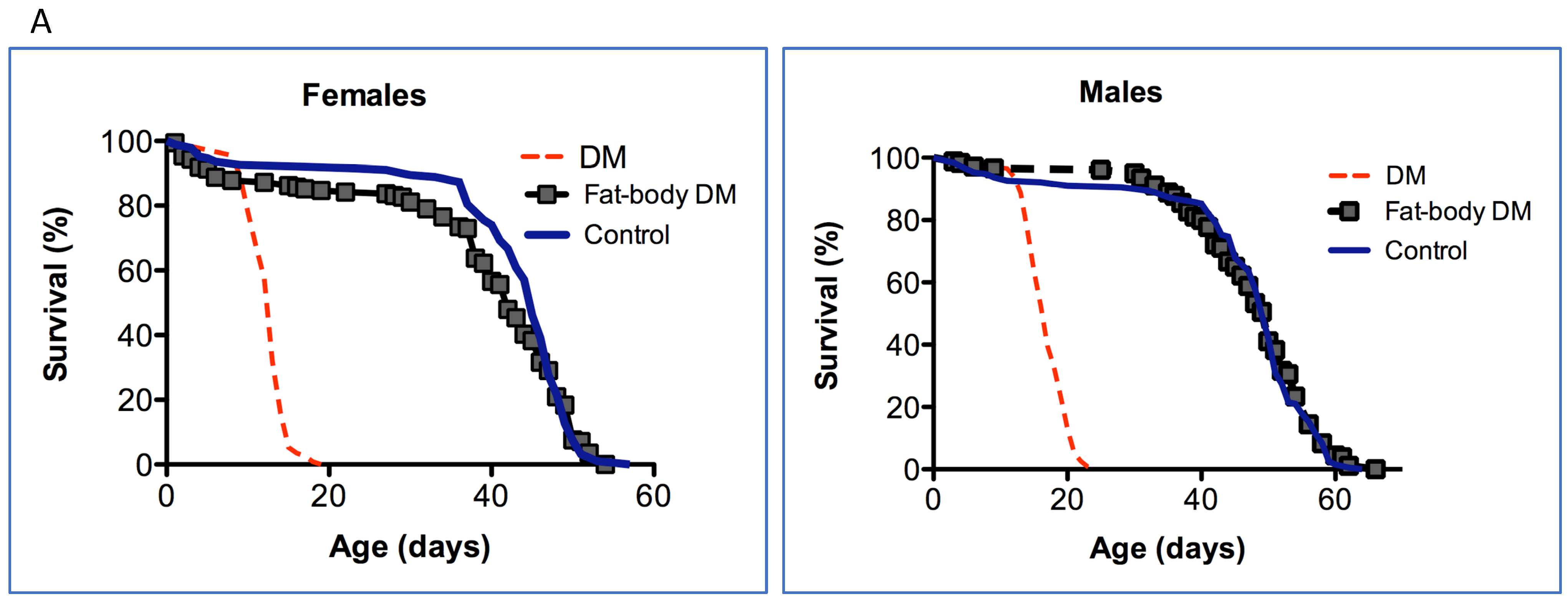
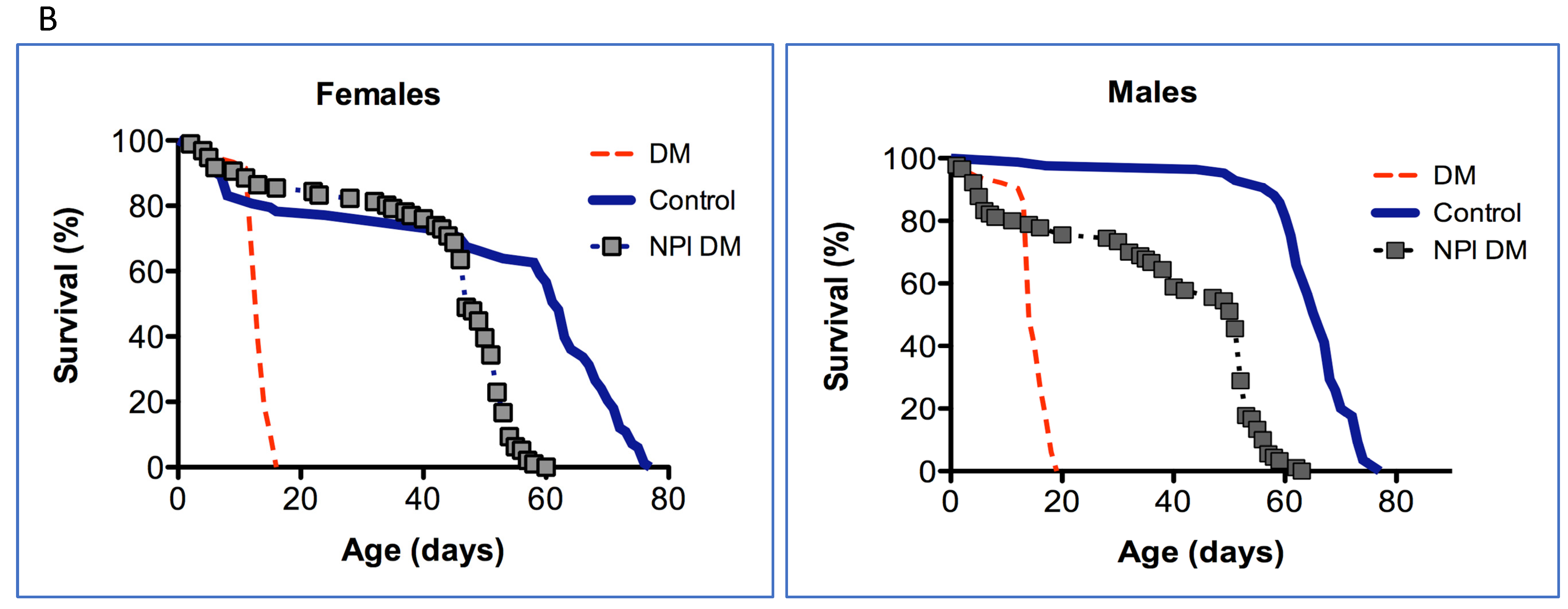
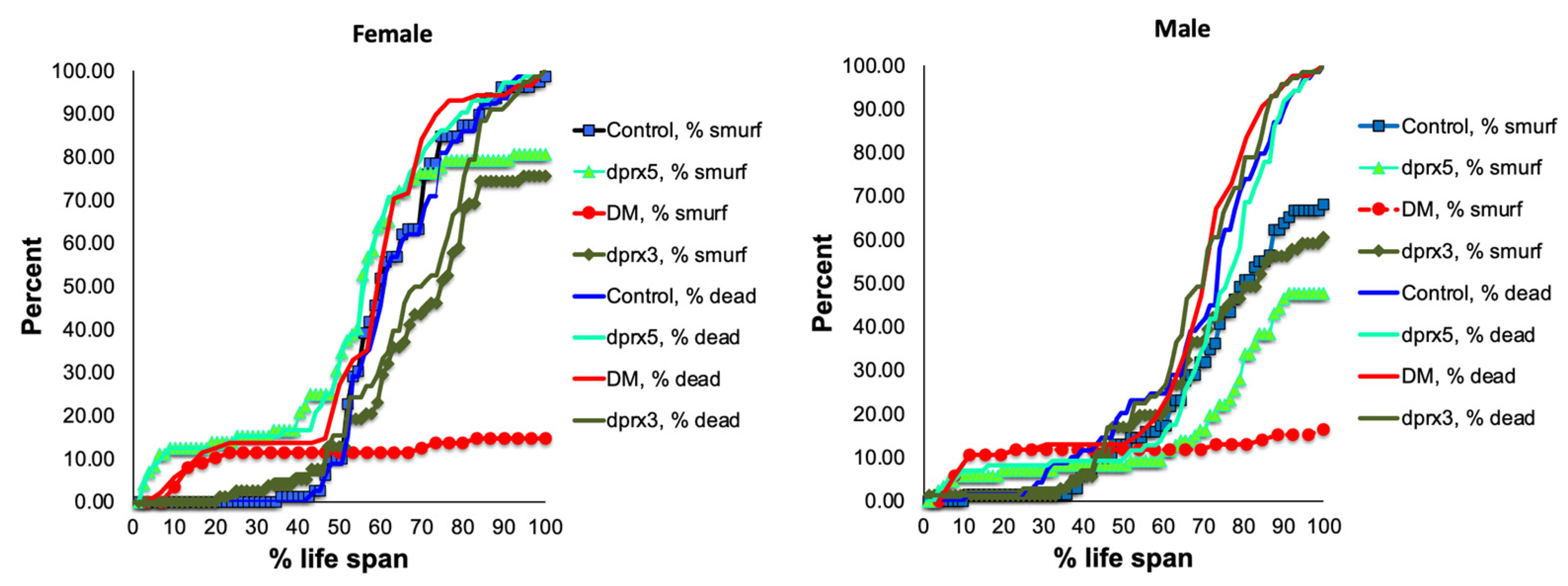
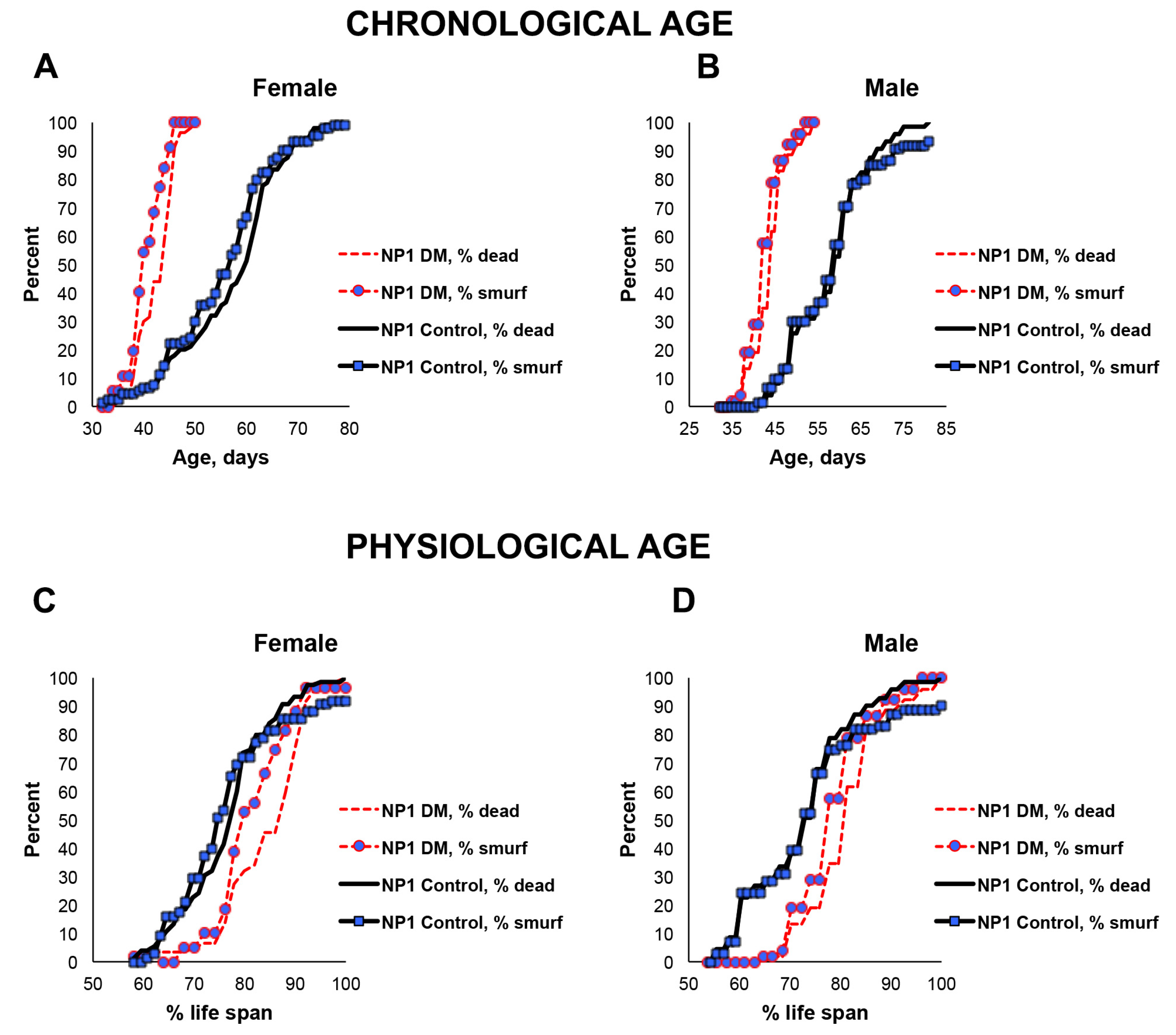
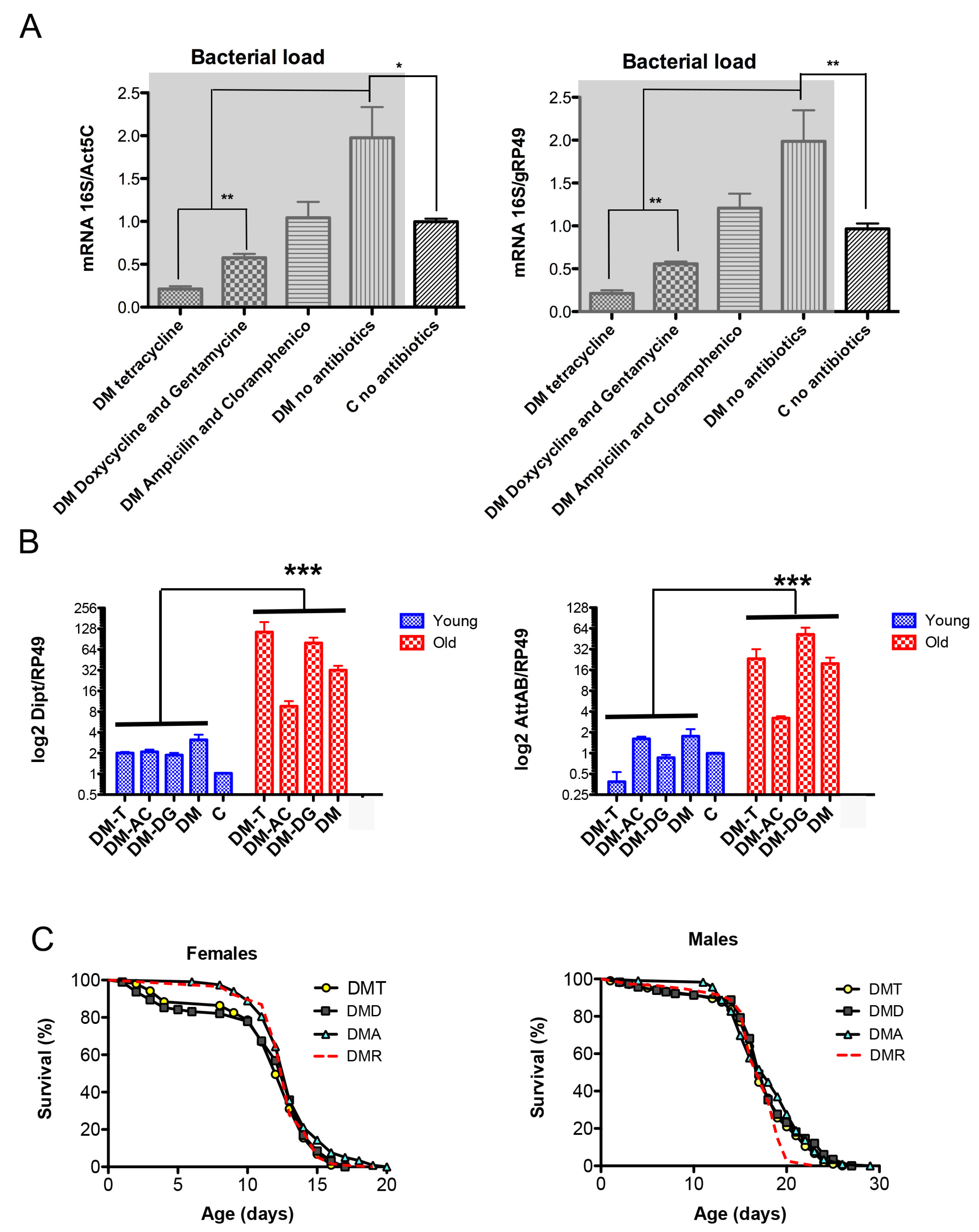
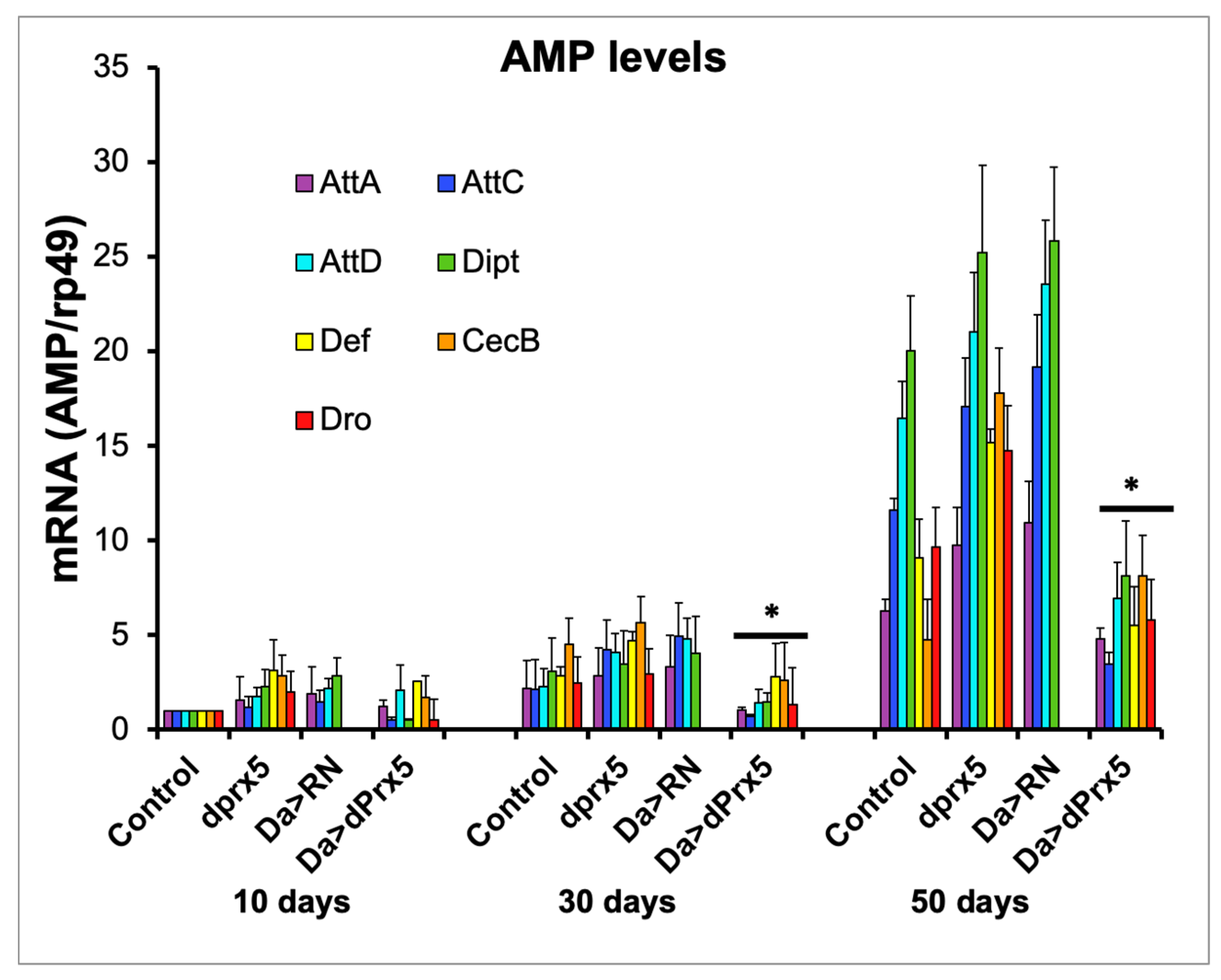

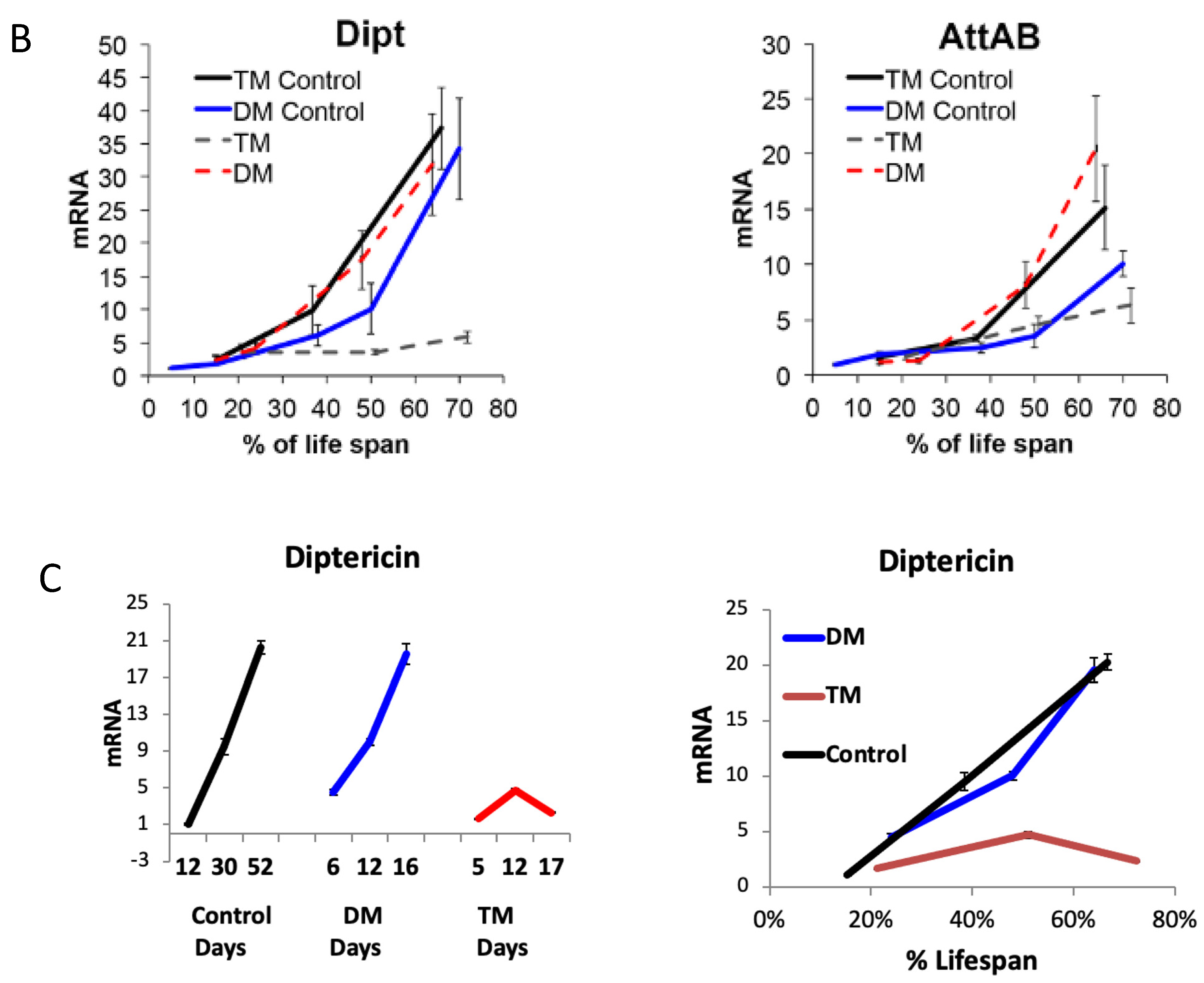
| Genotypes and Abbreviations of Transgenic Lines | ||
| Line Name | Genotype | Abbreviation |
| dprx5 null mutant | dprx5/Da-GAL4, dprx5 | dprx5 |
| RNAi-dprx3 transgenic flies | RNAi-dprx3/Da-GAL4, dprx5 | dprx3 |
| Double mutant | RNAi-dprx3, dprx5/Da-GAL4, dprx5 | DM |
| Control or double-mutant control | +/Da-GAL4, dprx5 | Control or DM control |
| Triple mutant | RNAi-dprx4/+; RNAi-dprx3, dprx5/Da-GAL4, dprx5 | TM |
| Triple-mutant control | RNAi-dprx4/+; RNAi-dprx3, dprx5/+ | TM control |
| Genotypes and Abbreviations of Flies with Tissue-Specific under Expression of dPrx3 in dprx5 Null Mutant Background | ||
| Line Name | Genotype | Abbreviation |
| Intestinal DM | +/+; NP1-GAL4/+; RNAi-dprx3, dprx5/dprx5 | NP1 DM |
| Intestinal control | +/+; NP1-GAL4/+; dprx5/+ | NP1 control |
| Fat-body DM (with mifepristone 100 μg/mL) | +/+; S106-pSwitch-GAL4/+; RNAi-dprx3, dprx5/dprx5 | S106 DM |
| Fat-body control (with ethanol, diluent of mifepristone) | +/+; S106-pSwitch-GAL4/+; RNAi-dprx3, dprx5/dprx5 | S106 control |
| Females | Males | ||||||
|---|---|---|---|---|---|---|---|
| 1 | 2 | 3 | 4 | 5 | 6 | ||
| Line | Mean, Days | % vs. Control | p-Value | Line | Mean, Days | % vs. Control | p-Value |
| S106 Control | 45 | S106 Control | 49 | ||||
| 44 | 40 | ||||||
| S106 DM | 42 | −6.67 | >0.05 | S106 DM | 50 | +2.00 | >0.05 |
| 37 | −15.91 | >0.05 | 40 | 0.00 | >0.05 | ||
| NP1 Control | 58 | NP1 Control | 62 | ||||
| 63 | 67 | ||||||
| NP1 DM | 47 | −18.97 | <0.0001 | NP1 DM | 40 | −35.48 | <0.0001 |
| 41 | −34.92 | <0.0001 | 51 | −23.88 | <0.0001 | ||
| DM | 15 | −74.14 | <0.0001 | DM | 19 | −69.35 | <0.0001 |
| 13 | −79.37 | <0.0001 | 14 | −79.37 | <0.0001 | ||
| 1 | 2 | 3 | 4 | 5 | |
|---|---|---|---|---|---|
| Line | Mean, Days | % vs. TM Control | p-Value | % vs. DM | p-Value |
| Females | |||||
| DM | 12 | ||||
| 14 | |||||
| TM | 13 | −78.33 | <0.0001 | +8.33 | <0.0001 |
| 14 | 0.00 | p > 0.05 | |||
| DM Control | 62 | +3.33 | p > 0.05 | +416.67 | <0.0001 |
| TM Control | 60 | ||||
| Males | |||||
| DM | 17 | ||||
| 13.5 | |||||
| TM | 15 | −75.00 | <0.0001 | −11.76 | <0.0001 |
| 13 | −3.70 | <0.0001 | |||
| DM Control | 61 | +1.67 | p > 0.05 | +258.82 | <0.0001 |
| TM Control | 60 | ||||
| Line | Slope, p-Value | Significance | Intercepts, p-Value | Significance |
|---|---|---|---|---|
| Dipt | ||||
| DM vs. TM | 0.0038 | Very significant | ||
| TM vs. TM Control | <0.0001 | Extremely significant | ||
| DM vs. DM Control | 0.595 | Not significant | 0.8306 | Not significant |
| TM Control vs. DM Control | 0.3628 | Not significant | 0.4407 | Not significant |
| AttAB | ||||
| DM vs. TM | 0.024 | Significant | ||
| TM vs. TM Control | 0.0098 | Very significant | ||
| DM vs. DM Control | 0.0030 | Very significant | ||
| TM Control vs. DM Control | 0.0076 | Very significant | ||
Disclaimer/Publisher’s Note: The statements, opinions and data contained in all publications are solely those of the individual author(s) and contributor(s) and not of MDPI and/or the editor(s). MDPI and/or the editor(s) disclaim responsibility for any injury to people or property resulting from any ideas, methods, instructions or products referred to in the content. |
© 2023 by the authors. Licensee MDPI, Basel, Switzerland. This article is an open access article distributed under the terms and conditions of the Creative Commons Attribution (CC BY) license (https://creativecommons.org/licenses/by/4.0/).
Share and Cite
Odnokoz, O.; Earland, N.; Badinloo, M.; Klichko, V.I.; Benes, J.; Orr, W.C.; Radyuk, S.N. Peroxiredoxins Play an Important Role in the Regulation of Immunity and Aging in Drosophila. Antioxidants 2023, 12, 1616. https://doi.org/10.3390/antiox12081616
Odnokoz O, Earland N, Badinloo M, Klichko VI, Benes J, Orr WC, Radyuk SN. Peroxiredoxins Play an Important Role in the Regulation of Immunity and Aging in Drosophila. Antioxidants. 2023; 12(8):1616. https://doi.org/10.3390/antiox12081616
Chicago/Turabian StyleOdnokoz, Olena, Noah Earland, Marziyeh Badinloo, Vladimir I. Klichko, Judith Benes, William C. Orr, and Svetlana N. Radyuk. 2023. "Peroxiredoxins Play an Important Role in the Regulation of Immunity and Aging in Drosophila" Antioxidants 12, no. 8: 1616. https://doi.org/10.3390/antiox12081616
APA StyleOdnokoz, O., Earland, N., Badinloo, M., Klichko, V. I., Benes, J., Orr, W. C., & Radyuk, S. N. (2023). Peroxiredoxins Play an Important Role in the Regulation of Immunity and Aging in Drosophila. Antioxidants, 12(8), 1616. https://doi.org/10.3390/antiox12081616







